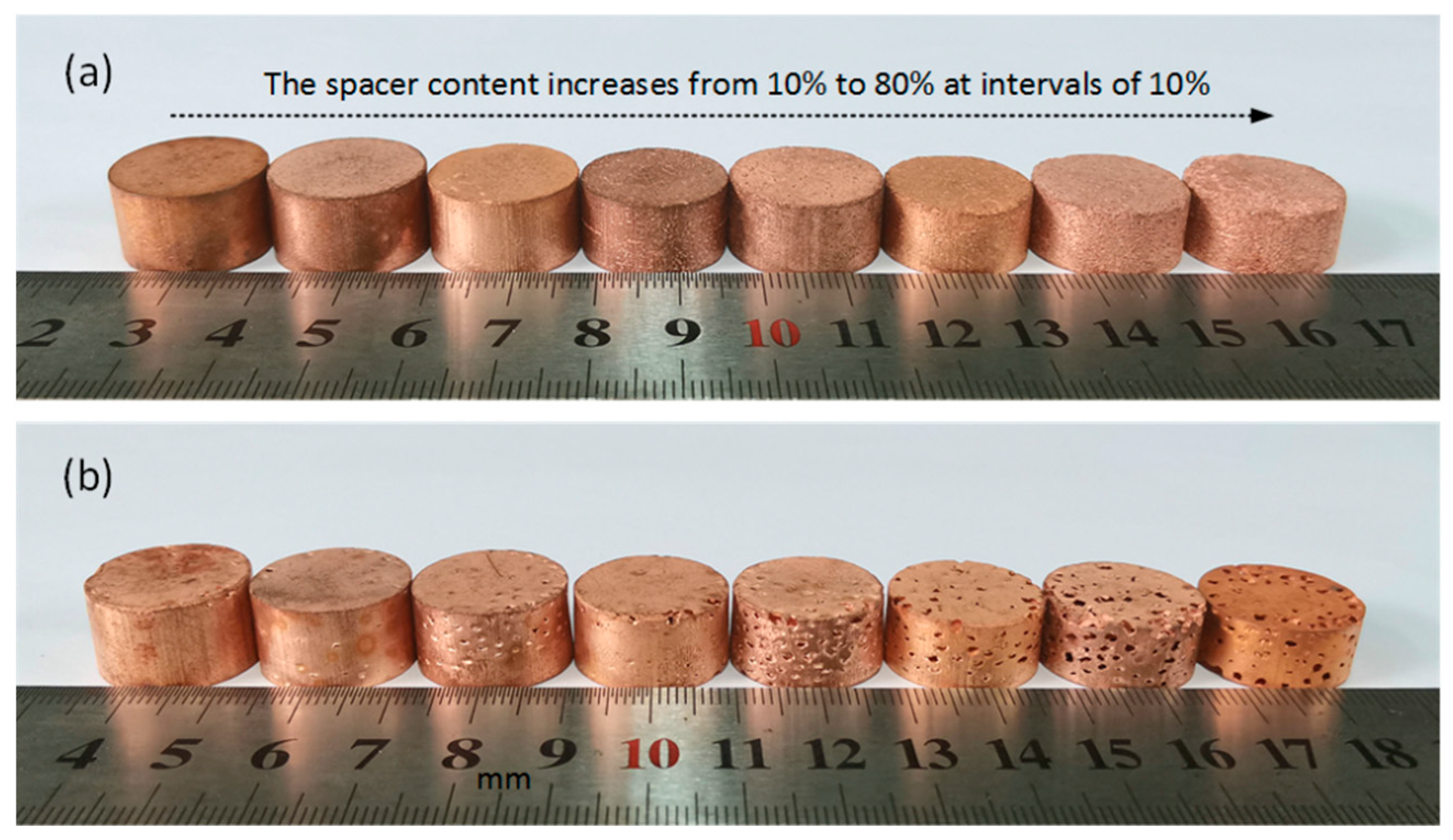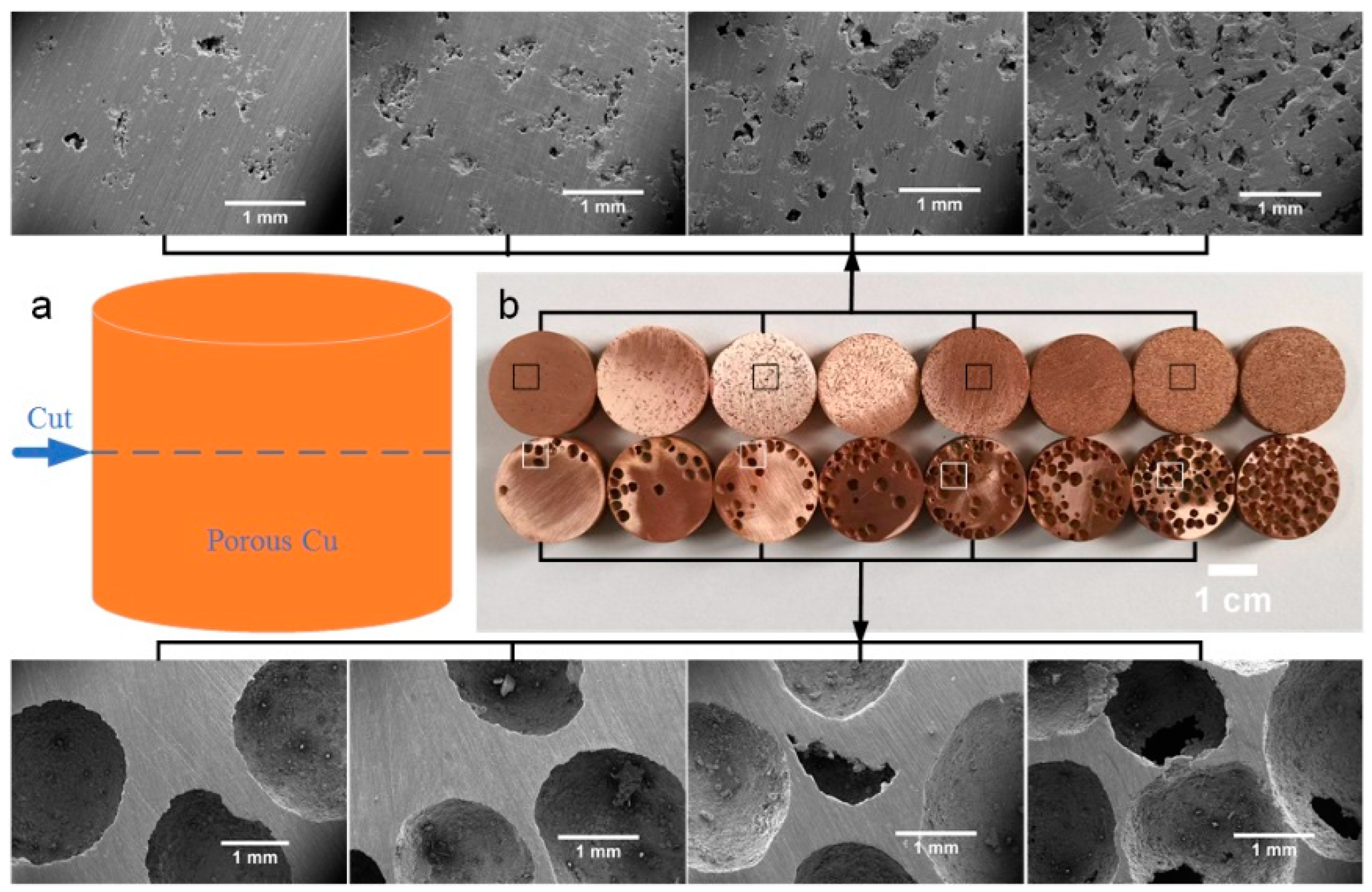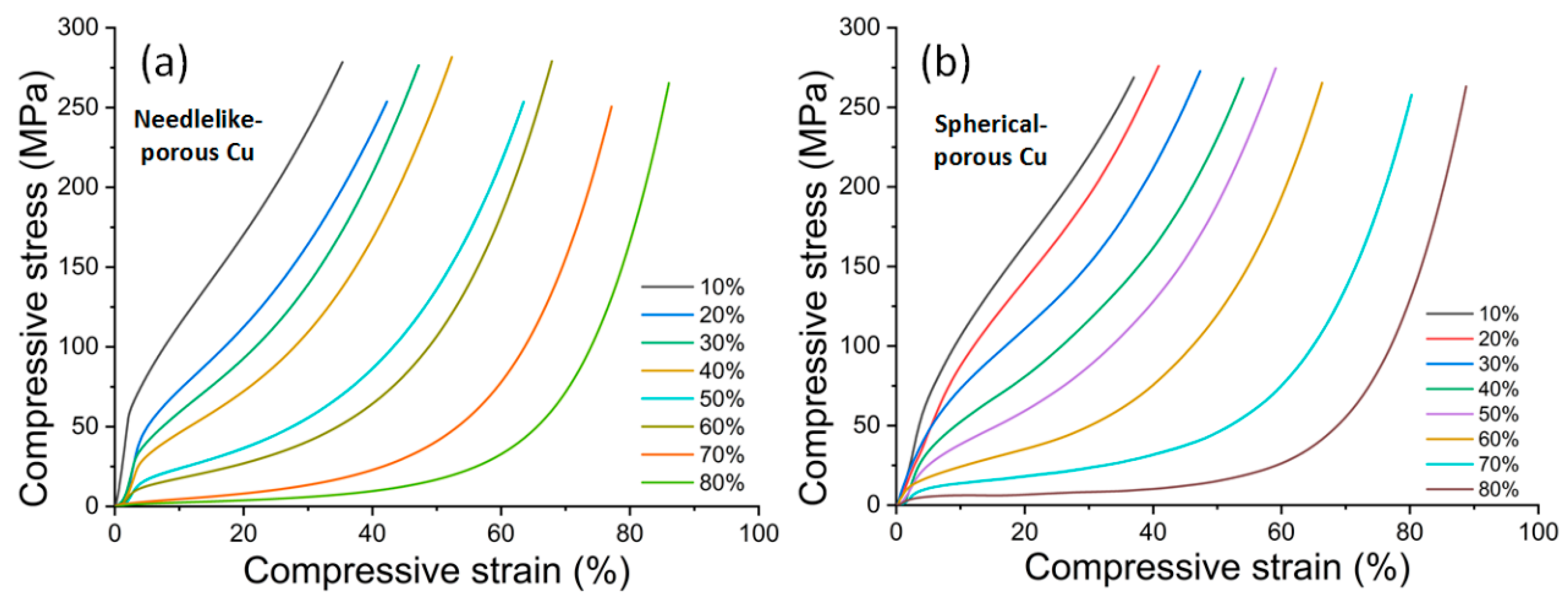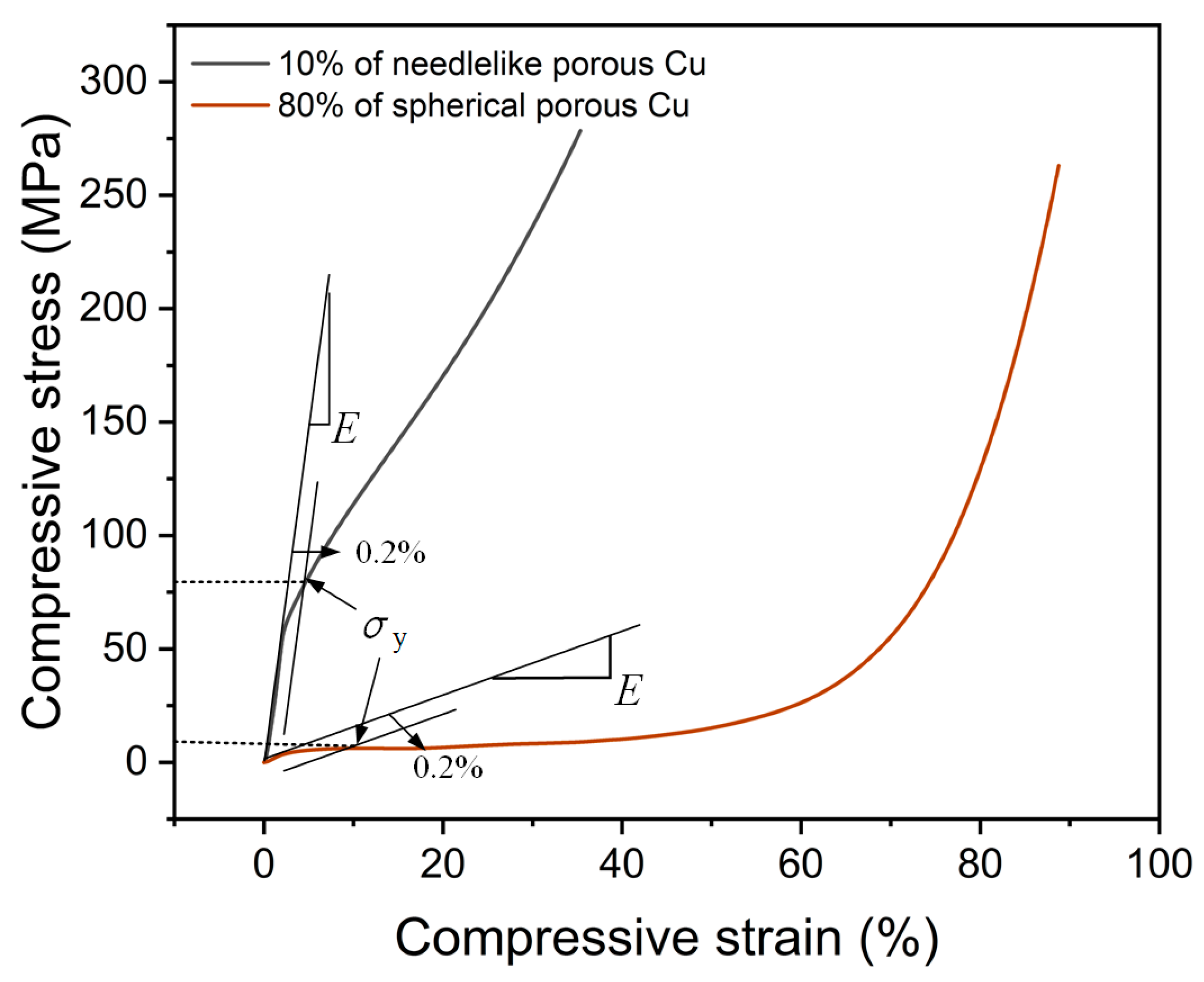Effects of the Space Holder Shape on the Pore Structure and Mechanical Properties of Porous Cu with a Wide Porosity Range
Abstract
:1. Introduction
2. Materials and Methods
3. Results and Discussion
3.1. Pore Structure
3.2. Mechanical Properties
3.3. Performance Prediction
4. Conclusions
Author Contributions
Funding
Institutional Review Board Statement
Informed Consent Statement
Data Availability Statement
Conflicts of Interest
References
- Lu, X.K.; Zhang, Y.B.; Xiao, S.J.; Zhao, Y.; Li, J.S.; Zhou, J.; Ouyang, Q.B. Effect of structural characteristics on the natural convective heat transfer performance of copper foam. Appl. Therm. Eng. 2022, 204, 118031. [Google Scholar] [CrossRef]
- Banhart, J. Manufacture, characterisation and application of cellular metals and metal foams. Prog. Mater. Sci. 2001, 46, 559–632. [Google Scholar] [CrossRef]
- Zhao, Y.Y.; Fung, T.; Zhang, L.P.; Zhang, F.L. Lost carbonate sintering process for manufacturing metal foams. Scripta Mater. 2005, 52, 295–298. [Google Scholar] [CrossRef]
- Shirjang, E.; Akbarpour, M.R. Influence of severe plastic deformation of Cu powder and space holder content on microstructure, thermal and mechanical properties of copper foams fabricated by lost carbonate sintering method. J. Mater. Res. Technol. 2023, 26, 5437–5449. [Google Scholar] [CrossRef]
- Ray, S.; Jana, P.; Kar, S.K.; Roy, S. Influence of monomodal K2CO3 and bimodal K2CO3+NaCl as space holders on microstructure and mechanical properties of porous copper. Mater. Sci. Eng. A 2023, 862, 144516. [Google Scholar] [CrossRef]
- Jana, P.; Ray, S.; Goldar, D.; Kota, N.; Kar, S.K.; Roy, S. Study of the elastic properties of porous copper fabricated via the lost carbonate sintering process. Mater. Sci. Eng. A 2022, 836, 142713. [Google Scholar] [CrossRef]
- Luo, H.J.; Zhao, J.H.; Du, H.; Yin, W.; Qu, Y. Effect of Mg Powder’s Particle Size on Structure and Mechanical Properties of Ti Foam Synthesized by Space Holder Technique. Materials 2022, 15, 8863. [Google Scholar] [CrossRef]
- Jain, H.; Gupta, G.; Mondal, D.P.; Srivastava, A.K.; Pandey, A.; Srivastava, S.K.; Kumar, R. Effect of particle shape on microstructure and compressive response of 316L SS foam by space holder technique. Mater. Chem. Phys. 2021, 271, 124924. [Google Scholar] [CrossRef]
- Mondal, D.P.; Patel, M.; Jain, H.; Jha, A.K.; Das, S.; Dasgupta, R. The effect of the particle shape and strain rate on microstructure and compressive deformation response of pure Ti-foam made using acrowax as space holder. Mater. Sci. Eng. A 2015, 625, 331–342. [Google Scholar] [CrossRef]
- Xiao, J.; Liu, Y.N.; Li, Y.; Qiu, G.B.; Liu, J.M. The application of model equation method in preparation of titanium foams. J. Mater. Res. Technol. 2021, 13, 121–127. [Google Scholar]
- Xiao, J.; Li, X.; Cai, Y.H.; Li, X.T.; Lin, Y.Q.; Xi, J.T. The application of the model equation method in the preparation of porous copper by using needlelike and spherical carbamide as a space holder. Powder Metall. 2023, 66, 365–376. [Google Scholar]
- Xiao, J.; Li, Y.; Liu, J.M.; Zhao, Q.L. Fabrication and Characterization of Porous Copper with Ultrahigh Porosity. Metals 2022, 12, 1263. [Google Scholar] [CrossRef]
- British Standards Institute. Mechanical Testing of Metals-Ductility Testing-Compression Test for Porous and Cellular Metals; British Standards Institute: Geneva, Switzerland, 2011. [Google Scholar]
- Miltz, J.; Gruenbaum, G. Evaluation of cushioning properties of plastic foams from compressive measurements. Polym. Eng. Sci. 1981, 21, 1010–1014. [Google Scholar] [CrossRef]
- Hakamada, M.; Asao, Y.; Kuromura, T.; Chen, Y.Q.; Kusuda, H.; Mabuchi, M. Density dependence of the compressive properties of porous copper over a wide density range. Acta Mater. 2007, 55, 2291–2299. [Google Scholar] [CrossRef]
- Gibson, L.J.; Ashby, M.F. Cellular Solids: Structure and Properties; Cambridge University Press: Cambridge, UK, 1999. [Google Scholar]
- Ashby, M.F.; Evans, A.G.; Fleck, N.A.; Gibson, L.J.; Hutchinson, J.W.; Wadley, H.N.G. Metal Foams: A Design Guide; Elsevier: Amsterdam, The Netherlands, 2000. [Google Scholar]
- Hong, K.; Kadar, C.; Knapek, M.; Drozdenko, D.; Jenei, P.; Kim, M.Y.; Choe, H.; Mathis, K.; Park, H.; Gubicza, J. Comparison of morphology and compressive deformation behavior of copper foams manufactured via freeze-casting and space-holder methods. J. Mater. Res. Technol. 2021, 15, 6855–6865. [Google Scholar] [CrossRef]
- Badwe, N.; Chen, X.Y.; Sieradzki, K. Mechanical properties of nanoporous gold in tension. Acta Mater. 2017, 129, 251–258. [Google Scholar] [CrossRef]
- Bolzoni, L.; Carson, J.K.; Yang, F. Combinatorial structural-analytical models for the prediction of the mechanical behaviour of isotropic porous pure metals. Acta Mater. 2021, 207, 116664. [Google Scholar] [CrossRef]
- Jenei, P.; Kádár, C.; Szabó, A.; Hung, S.M.; Kuo, C.J.; Choe, H.; Gubicza, J. Mechanical behavior of freeze-cast Ti foams with varied porosity. Mater. Sci. Eng. A 2022, 855, 143911. [Google Scholar] [CrossRef]
- Tuncer, N.; Arslan, G.; Maire, E.; Salvo, L. Influence of cell aspect ratio on architecture and compressive strength of titanium foams. Mater. Sci. Eng. A 2011, 528, 7368–7374. [Google Scholar] [CrossRef]
- Cheneler, D.; Kennedy, A.R. A comparison of the manufacture and mechanical performance of porous aluminium and aluminium syntactic foams made by vacuum-assisted casting. Mater. Sci. Eng. A 2020, 789, 139528. [Google Scholar] [CrossRef]







| Spacer Content (%) | 10 | 20 | 30 | 40 | 50 | 60 | 70 | 80 |
|---|---|---|---|---|---|---|---|---|
| Porosity of NP-Cu/% | 26.4 ± 1.5 | 39.1 ± 0.1 | 38.7 ± 0.8 | 42.4 ± 1 | 57.4 ± 0.5 | 59 ± 0.6 | 72.5 ± 0.1 | 79.3 ± 0.2 |
| Porosity of SP-Cu/% | 28.9 ± 1.1 | 32.1 ± 0.4 | 39.8 ± 0.9 | 46.4 ± 0.9 | 53.8 ± 0.9 | 62.3 ± 1 | 71.2 ± 0.1 | 79.7 ± 0.3 |
| Spacer Content (%) | Elastic Modulus (GPa) | Yield Strength (MPa) | ||
|---|---|---|---|---|
| NP-Cu | SP-Cu | NP-Cu | SP-Cu | |
| 10 | 3.07 ± 0.41 | 1.58 ± 0.12 | 63.85 ± 15.02 | 68.98 ± 4.29 |
| 20 | 2.05 ± 0.36 | 1.14 ± 0.07 | 44.78 ± 4.34 | 71.53 ± 7.99 |
| 30 | 1.58 ± 0.05 | 1.22 ± 0.08 | 31.82 ± 0.94 | 41.85 ± 2.54 |
| 40 | 1.67 ± 0.38 | 1.05 ± 0.10 | 25.26 ± 0.77 | 30.63 ± 2.62 |
| 50 | 1.00 ± 0.20 | 0.70 ± 0.03 | 9.21 ± 2.13 | 23.31 ± 1.49 |
| 60 | 0.59 ± 0.10 | 0.54 ± 0.03 | 11.29 ± 0.59 | 11.66 ± 0.97 |
| 70 | 0.44 ± 0.22 | 0.43 ± 0.02 | 3.67 ± 1.30 | 8.78 ± 0.76 |
| 80 | 0.05 ± 0.01 | 0.19 ± 0.02 | 1.85 ± 0.42 | 4.36 ± 0.32 |
| Spacer Content (%) | Compressive Strength (MPa) | Densification Strain (%) | ||
|---|---|---|---|---|
| NP-Cu | SP-Cu | NP-Cu | SP-Cu | |
| 60 | 117.65 ± 6.34 | 132.02 ± 35.99 | 51.35 ± 0.72 | 53.47 ± 3.57 |
| 70 | 33.26 ± 1.19 | 49.58 ± 8.15 | 45.78 ± 1.04 | 47.98 ± 1.74 |
| 80 | 12.07 ± 0.66 | 11.79 ± 2.45 | 45.43 ± 0.45 | 43.47 ± 5.08 |
| Literature | Skeleton Metal | Elastic Modulus | Yield Strength | Porosity (%) |
|---|---|---|---|---|
| Ray [5] | Cu | E/Es = (1 − P)(2.6−4.14) | - | 38.5–70.4 |
| Hong [18] | Cu | - | σy/σys = 0.6(1 − P)2.28 | 70.2–76.6 |
| Jana [6] | Cu | E/Es = 192.61 − 11.09P + 0.27P2 − 0.003P3 + 1.39 × 10−5P4 | 27.5–67.1 | |
| Badwe [19] | Au | E/Es = 0.86(1 − P)2.8 | - | 43–70 |
| Bolzoni [20] | Ti | E/Es = 0.79(1 − P)2.49 | - | 44.3–71.1 |
| Fe | E/Es = 0.90(1 − P)2.54 | 38.1–75.6 | ||
| Jenei [21] | Ti | E/Es = 1.3(1 − P)4.6 | σy/σys = 10.2(1 − P)5 | 51–68.4 |
| Tuncer [22] | Ti | - | σy/σys = 1.07(1 − P)2.28−2.57 | 44–68 |
| Cheneler [23] | Al | E/Es = 7.38(1 − P)2.71 | σy/σys = 24.6(1 − P)2.71 | ~80–85% |
| E/Es = 5.32(1 − P)2.92 | σy/σys = 21.81(1 − P)3.09 | |||
Disclaimer/Publisher’s Note: The statements, opinions and data contained in all publications are solely those of the individual author(s) and contributor(s) and not of MDPI and/or the editor(s). MDPI and/or the editor(s) disclaim responsibility for any injury to people or property resulting from any ideas, methods, instructions or products referred to in the content. |
© 2024 by the authors. Licensee MDPI, Basel, Switzerland. This article is an open access article distributed under the terms and conditions of the Creative Commons Attribution (CC BY) license (https://creativecommons.org/licenses/by/4.0/).
Share and Cite
Xiao, J.; He, Y.; Ma, W.; Yue, Y.; Qiu, G. Effects of the Space Holder Shape on the Pore Structure and Mechanical Properties of Porous Cu with a Wide Porosity Range. Materials 2024, 17, 3008. https://doi.org/10.3390/ma17123008
Xiao J, He Y, Ma W, Yue Y, Qiu G. Effects of the Space Holder Shape on the Pore Structure and Mechanical Properties of Porous Cu with a Wide Porosity Range. Materials. 2024; 17(12):3008. https://doi.org/10.3390/ma17123008
Chicago/Turabian StyleXiao, Jian, Yanping He, Wenjun Ma, Yiheng Yue, and Guibao Qiu. 2024. "Effects of the Space Holder Shape on the Pore Structure and Mechanical Properties of Porous Cu with a Wide Porosity Range" Materials 17, no. 12: 3008. https://doi.org/10.3390/ma17123008





